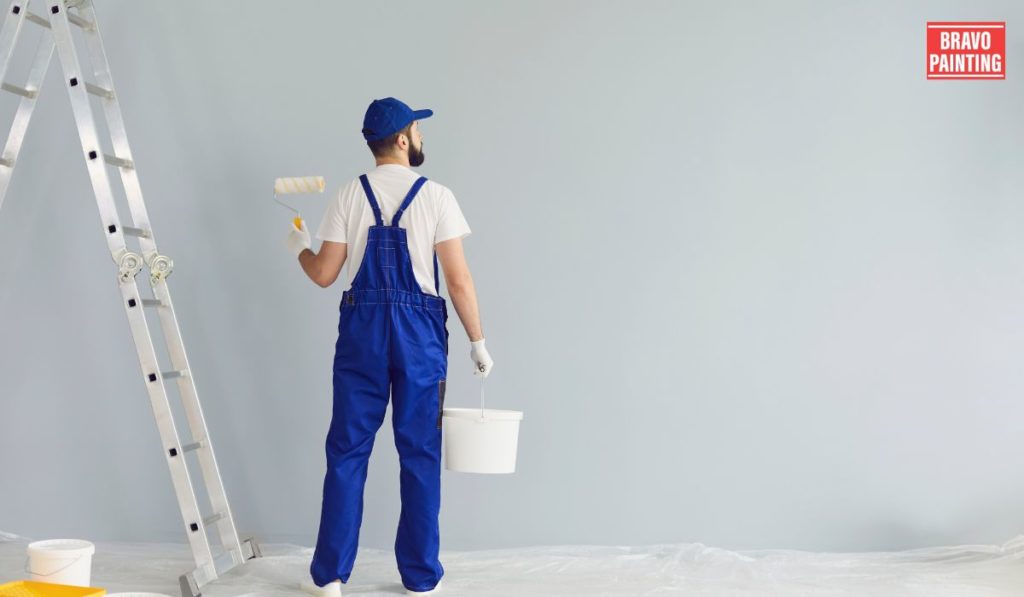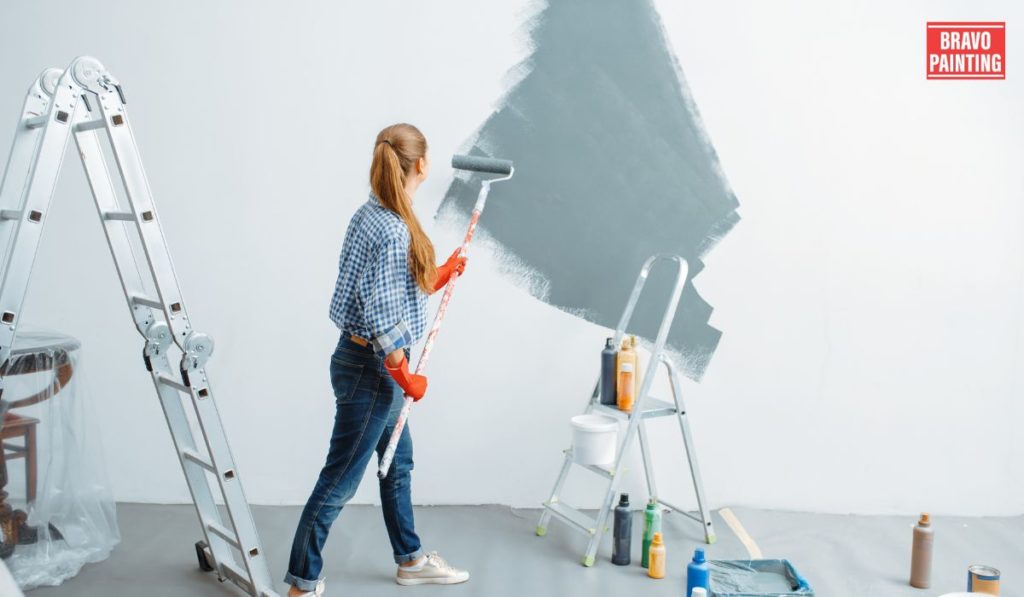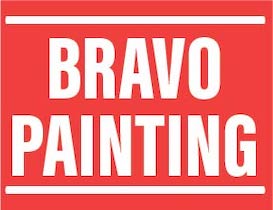Interior Wall Painting can transform the look and feel of your space, giving it a fresh and vibrant appeal. With a few expert tips and techniques, you can achieve professional-looking results. Here’s a step-by-step guide to help you do Interior Wall Painting like a pro.
Preparing Your Interior Walls For Painting
Before you start painting, it’s crucial to prepare your home for interior painting. Begin by removing any artwork, nails, or hooks from the walls. Then, inspect the walls for any cracks, holes, or imperfections. Fill these with spackling compound and sand them smooth once dry. Next, clean the walls using a mild detergent and water solution to remove dirt, dust, and grease. Allow the walls to dry completely before proceeding to the next step.
Gathering Tools & Materials
Interior Wall Painting effectively, gather the necessary tools and materials beforehand. You’ll need paint rollers, brushes, drop cloths or plastic sheets to protect floors and furniture, painter’s tape to create clean edges, a ladder or step stool for reaching high areas, and a paint tray for pouring the paint. Additionally, ensure you have enough paint for the project and choose the right type and finish for your walls.
Choosing The Right Paint Color And Finish
Selecting the right paint color and finish is essential for achieving the desired look and ambiance in your space. Consider the existing decor, lighting, and personal preferences when choosing a perfect color. Sample paint colors on the walls to see how they appear in different lighting conditions. As for the finish, flat or matte finishes work well for low-traffic areas, while satin or semi-gloss finishes are more durable and suitable for high-traffic areas.
Priming Walls – Do You Really Need To?

While priming is not always necessary, it can be beneficial in certain situations. Priming helps to create a smooth and uniform surface, especially when painting over dark or bold colors. It also helps the paint adhere better and improves the overall durability of the finish. If you’re changing the wall color significantly or painting over a porous surface, using a primer can save you time and money in the long run.
Painting Techniques For Different Types Of Walls
Different types of Interior Wall Painting require different painting techniques for optimal results. For smooth walls, use a roller for larger areas and a brush for cutting in along edges and corners. Textured walls may require a thicker nap roller to reach into crevices and create an even coat. When dealing with drywall or new surfaces, apply a coat of primer before painting. Remember to maintain a consistent pressure and avoid overworking the paint to prevent streaks or visible brush marks.
How To Maintain Your Painted Interior Walls?
Once you’ve painted your interior walls, proper maintenance is essential to ensure their longevity and appearance. Avoid scrubbing or using abrasive cleaners on painted surfaces, as this can damage the paint. Instead, use a soft cloth or sponge and a mild detergent solution to clean any stains or marks gently. Regular dusting can help prevent the buildup of dirt and grime. If you notice any chips or scuffs, touch up the affected areas promptly to maintain a professional look.
Creating A Professional Look On Your Interior Walls
Attention to detail is critical to achieving a professional look on your Interior Wall Painting. Take the time to properly prepare the walls, including filling cracks and sanding imperfections. Use painter’s tape to create clean lines and edges. Apply paint in even coats, allowing each coat to dry before applying the next. Consider using a technique like “cutting in” to achieve sharp edges between walls and ceilings or contrasting colors. Finally, remove the tape carefully once the paint is dry to avoid any accidental smudging or peeling of the paint.
FAQs
How do you prepare interior walls for painting?
To prepare interior walls for painting, start by removing any artwork, nails, or hooks. Fill any cracks or holes with spackling compound and sand them smooth. Clean the walls using a mild detergent and water solution to remove dirt and grease. Allow the walls to dry completely before proceeding.
What order do you paint interior walls?
The recommended order for painting interior walls is to start with the ceiling, followed by the walls, and then the trim. This ensures that any paint drips or splatters from the ceiling or walls can be easily covered when painting the trim.
What should you not do while painting interior walls?
While painting interior walls, avoid common mistakes such as painting over dirty or greasy surfaces, neglecting to use painter’s tape for clean lines, rushing the process without proper preparation, and applying too thick of a coat, leading to drips and uneven coverage.
Can you just paint over a painted wall?
Yes, you can paint over a painted wall. However, it’s essential to ensure that the existing paint is in good condition, clean, and properly adhered to the wall. Lightly sand the surface to create a better bonding surface, and apply a primer if necessary.
Is it necessary to wash walls before painting?
Yes, it is necessary to wash walls before painting. Cleaning the walls removes dirt, dust, and grease, ensuring better paint adhesion and a smoother finish. Use a mild detergent and water solution and allow the walls to dry completely before painting.
Do professional painters wash walls before painting?

Yes, professional painters typically wash walls before painting. It is a standard practice to ensure a clean surface for optimal paint adhesion and a high-quality finish.
How many coats of paint do I need for interior walls?
The number of coats of paint needed for interior walls depends on factors such as the color change, quality of the paint, and the condition of the walls. In most cases, two coats of paint are sufficient for an even and durable finish.
How do you paint a room fast like a professional?
To paint a room quickly like a professional, start by preparing the walls properly, including patching and cleaning. Use a roller for larger areas and a brush for cutting in. Work in small sections, maintaining a wet edge to avoid visible lines. Opt for a high-quality paint that provides good coverage, and use techniques like rolling in a “W” pattern for efficient and even application.
Do you paint sideways or up and down?
When using a roller to paint interior walls, it’s recommended to paint in an up-and-down or vertical motion. This helps to ensure even coverage and avoids streaks or lines that may occur when painting sideways.
Can I just paint over old paint?
Yes, you can paint over old paint. However, it’s important to assess the condition of the existing paint. If it is in good condition, clean, and properly adhered to the wall, you can proceed with painting directly over it after light surface preparation.
What happens if I don’t wash walls before painting?
If you don’t wash the walls before painting, the paint may not adhere properly, resulting in poor coverage, uneven color, and potential paint failure. Dirt, dust, and grease on the walls can also create a barrier that prevents the new paint from bonding effectively.
Is there a wrong way to paint walls?
While there are no strict rules on how to paint walls, there are common mistakes to avoid. These include neglecting proper wall preparation, using low-quality or mismatched paint, applying too thick of a coat, not using painter’s tape for clean edges, and rushing the process without allowing proper drying time between coats. It’s important to follow best practices to achieve a professional and long-lasting finish.
Do professional painters use 2 coats of paint?
Yes, professional painters often use 2 coats of paint for interior walls. Applying multiple coats ensures better coverage, evens out the color, and enhances the durability and longevity of the paint job. However, the number of coats required may vary depending on factors such as the color change, type of paint, and the condition of the walls.
Can you put two coats of paint on a wall in one day?
While it is technically possible to apply two coats of paint on a wall in one day, it is generally not recommended. It’s important to allow sufficient drying time between coats to ensure proper adhesion and a smooth finish. Follow the drying instructions provided by the paint manufacturer to achieve the best results and avoid potential issues such as paint peeling or uneven drying.
Remember, proper surface preparation, using high-quality tools and materials, and following recommended painting techniques are essential for achieving professional-looking results when painting interior walls. Take your time, work systematically, and enjoy the process of transforming your living space with a fresh coat of paint.


